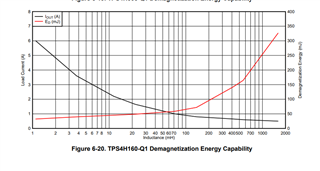Hi,
on the datasheet of TPS2H160A-Q1, the switch-off maximum clamping energy is defined just in one condition (single pulse, single channel, Vvs=13.5V, L=8mH, Tj=150°C).
I would like to know how much energy the device is able to dissipate in the following conditions:
- repetitive pulse (max frequency=500 Hz), single channel, Vvs=36V, L=14mH, Tj=125/150°C;
- repetitive pulse (max frequency=500 Hz), parallel channels, Vvs=36V, L=8mH, Tj=125/150°C.
An electro-thermal model of the device would be appreciated.
Regards,
Andrea


